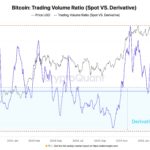
Surge in Bitcoin ETF Demand Following Price Surge Results in Record Inflows for 2025
Last week, spot Bitcoin ETFs experienced a notable turnaround as a surge of institutional investment poured into the market following a period of lackluster interest.
From April 21 to April 25, these ETFs garnered over $3 billion in net inflows, a striking figure that eclipsed the modest investment levels seen earlier in February and March.
Throughout the week, inflows were substantial each day, peaking on April 22 with nearly $936.5 million. This figure, reported by analysis platforms, was significantly higher than the average daily flows observed year-to-date, marking the largest single-day influx since at least November 2024, indicating an intense buying wave at the end of April.
The upsurge in inflows coincided with a sharp increase in Bitcoin’s price, suggesting a strong link between rising prices and institutional demand. Bitcoin started the week around $87,500, recovering from its early-April lows, and by April 25, it neared $95,000, reaching its highest value in about six weeks. As Bitcoin surged past critical price levels, more institutional investors entered the market through ETFs, likely contributing to additional upward momentum in spot prices.
Notably, the buying activity was widespread, with BlackRock’s IBIT seeing significant creations, and nearly all eleven U.S. Bitcoin ETFs experiencing net inflows during this week. This represented a shift from the usual trend where one leading fund captures most of the volume. Grayscale’s GBTC, on the other hand, continued to witness withdrawals as investors shifted towards the new ETFs, indicating a preference for these lower-cost, direct Bitcoin investment avenues as market sentiment improved.
For several months prior, Bitcoin ETFs had been losing assets, with almost every trading day reporting net outflows. The beginning of April was no exception, and by mid-April, total outflows for the month had reached approximately $812 million, with even popular ETFs like IBIT facing significant redemptions. The peak occurred on April 8, when over $326 million was pulled in a single day due to a sudden escalation in U.S.-China trade tensions, including unexpected tariffs announced by the White House, which triggered widespread market anxiety.
Bitcoin ETFs were not immune to this stress, as investors reduced their exposures amidst concerns over market volatility. Throughout early April, any signs of positive movement were short-lived; April 2 marked the only exception with a modest inflow of $218 million, occurring alongside geopolitical news that paradoxically encouraged some buying at lower prices. Overall, market sentiment remained cautious until the month reached its midway point.
As April advanced, several factors converged to drive a turnaround. Around April 12, signs indicated that the macroeconomic and political landscape was stabilizing, which alleviated some fears. U.S. President Donald Trump publicly declared there were no plans to replace the Federal Reserve Chair, reducing apprehensions about potential instability within the central bank. Additionally, the administration indicated a desire to ease trade tensions, with officials labeling the punitive tariffs as “unsustainable” and hinting at a potential truce with China.
This new tone of optimism had a ripple effect on global markets. A reduction in geopolitical tensions and assurance from central bank leadership encouraged investors to re-engage with riskier assets. Bitcoin demonstrated resilience despite earlier ETF outflows, quickly recovering its price toward the $85,000-$90,000 range by mid-April. The cryptocurrency’s rally occurred even as U.S. equities faltered, reflecting a potential decoupling from traditional market trends.
On April 22, as Bitcoin surged roughly 7%, gold prices also rose to record heights above $3,400 per ounce, indicating ongoing investor caution. Interestingly, Bitcoin’s gains were aligned more closely with gold than with stocks, showcasing its emerging role as a safe-haven asset similar to digital gold.
By the end of April, the investment landscape had transformed, rekindling interest in Bitcoin driven by optimistic economic sentiment as well as serving as a hedge against lingering macro fears. This environment prompted institutional investors, previously hesitant or withdrawn, to return in droves, favoring Bitcoin ETFs for their investments.
Beginning April 21, substantial inflows were recorded daily, reversing previous outflow trends. The initial momentum on April 21 saw a net inflow of about $387 million as the markets reopened following the Easter holiday, coinciding with Bitcoin breaking above $87,000.
The following day was particularly impressive, with approximately $936.5 million entering on April 22 alone, representing more than the total inflows for the first half of the month and propelling Bitcoin past the $93,000 mark. This staggering single-day inflow was about 11.5 times higher than the average daily inflow since the launch of these ETFs in January 2024, marking it as a significant anomaly according to analysts.
The upward trend persisted on April 23, adding another $917 million as Bitcoin remained just under $94,000. Even as the week continued and the initial excitement began to subside, Thursday still recorded about $442 million in additional inflows, followed by approximately $380 million on Friday, April 25. By the week’s conclusion, Bitcoin ETFs had collectively accumulated over $3 billion in new investments.



















Post Comment